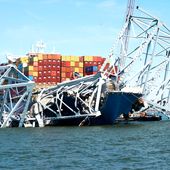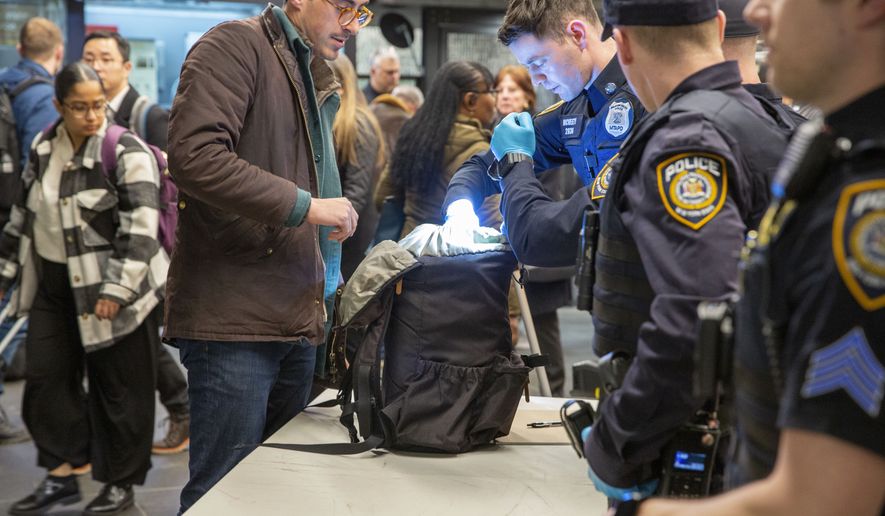Police officers patrolling trains and National Guard soldiers inspecting bags are part of what analysts call a wave of crime-fighting “theater” on transit systems that critics predict will do little to stop criminals from preying on passengers.
A spate of deadly shootings on buses, stabbings outside subway stations and erratic vagrants shoving people onto busy train tracks have persuaded elected leaders along the East Coast to flood their public transit systems with extra security resources.
New York Gov. Kathy Hochul, a Democrat, ordered the National Guard to conduct random bag searches at subway fare gates in New York City to try to catch gun-toting crooks.
The Washington Metropolitan Area Transit Authority has armed police riding the rails to deter vagrants and other riders from becoming violent.
The Philadelphia City Council is trying to address a series of shootings on the Southeastern Pennsylvania Transportation Authority bus system that has left three dead and 13 wounded.
Law enforcement veterans say criminals are clever enough to see past the “farce” in New York.
“It’s theater because, No. 1, some thug from Brooklyn or the Bronx that runs back and forth to Manhattan on a train is not carrying a duffel bag with guns,” said Bernard Kerik, who served as New York City police commissioner under Mayor Rudolph W. Giuliani.
Instead, he said, crooks are stuffing pistols or knives into their pants, especially when they see the checkpoints.
The result is a public safety performance that Mr. Kerik said “is not going to reduce violence in the subway system — not one bit.”
Trouble in Gotham
Ms. Hochul acknowledged last week that the National Guard deployment is as much about making riders feel “psychologically” safer on the subway than making trips safer.
Several high-profile acts of violence at stations have left New Yorkers on edge. A postal worker was shoved onto the tracks at Penn Station this month, a 60-year-old man was stabbed in the gut in the Bronx, and a subway conductor was slashed in the neck in February.
Police data showed crime on the subway was up 45% year-over-year in January but down 13% in February after the New York Police Department surged 1,000 officers to stations.
A small number of repeat offenders are responsible for much of the violence on the rails. NYPD said 38 people arrested on transit assaults last year were tied to more than 1,100 other crimes throughout the city. Officials said the state’s lax bail laws are a problem.
“We find ourselves arresting the same people over and over again, and we’ve got to ask ourselves why are we arresting certain people dozens of times, some people over 100 times. Where are the consequences for these recidivist criminals preying on our riders?” NYPD Transit Bureau Chief Michael Kemper told local Fox affiliate WNYW.
Passengers have told local media that the uniformed guard members bring a sense of security, but Mr. Kerik said plainclothes police riding the rails with commuters would be more effective. He said the NYPD is limited by its lack of manpower.
Recruitment numbers are dropping while veterans are leaving the force earlier, Mr. Kerik said, and enthusiasm for law enforcement work in New York is waning. In the process, police initiatives have been cut and straphangers are at risk.
Badges and bad guys
Some D.C. officials doubt that putting more police on trains would solve the capital region’s transit crime.
John R. Lott, president of the Crime Prevention Research Center, said having uniformed officers on Metro cars and buses would stop criminals only in the presence of police. Most criminals would wait until the officers switch train cars or bus lines before acting.
“My guess is it’s going to be a very boring job, particularly if you have officers in uniform because, unless the guys are really stupid, they’re not going to go and commit the crime,” Mr. Lott told The Times.
Metro said in a release last month that the uniformed officers are meant to “provide a sense of security and address illegal activity in real time.” Overall, the transit system has reported a 14% drop in crime since 2023.
Metro began cracking down on fare jumpers this week, thanks to a newly enacted crime law.
Riders who try to avoid paying the fare can face up to a $100 fine and arrest.
Shootings periodically erupted inside the transit system last year, mainly in the District.
A Metro mechanic was fatally shot on the Potomac Avenue platform in February while trying to help a woman being harassed by an armed man.
A teen boy was gunned down in May during an argument between the Waterfront and Navy Yard stations. In December, a 14-year-old boy was followed into the Petworth station and shot in the hip.
On March 1, a teen girl died in a “train surfing” accident near Silver Spring.
City of brotherly bloodletting
Philadelphia leaders are scrambling for a solution to a spike in shootings in and around the city’s SEPTA bus system.
The first was the March 3 gunning down of a man getting off a bus after an argument. The next day, a 17-year-old boy was mortally wounded in a shooting that left five others injured. A day later, a 37-year-old man died after he was shot in the chest aboard a bus.
Concerns reached an apex when eight high school students were shot while exiting a bus on March 7. All are expected to survive, but the violence rattled City Council members representing the area.
“I am feeling powerless and shrouded by a pull of desperation,” member Anthony Phillips said during the City Council’s weekly meeting on March 8. “This is a crisis at every level,” he said. The string of shootings is “not a SEPTA problem. It is a societal problem.”
Council President Kenyatta Johnson said city leaders want to add more anti-violence investments to Mayor Cherelle Parker’s budget proposal.
SEPTA Transit Police Chief Charles Lawson said gun crimes are up on buses but other crimes are down.
“We use every legal means at our disposal to target illegal gun possession on SEPTA,” Chief Lawson said during a press event. “We’re going to target individuals concealing their identity. We’re going to target fare evasion. We’re going to target open drug use. We’re going to target every criminal code on the books.”
In Harrisburg, Pennsylvania’s capital, Gov. Josh Shapiro, a Democrat, rejected the idea that Philadelphia needs to deploy the National Guard to address crime concerns. He did say he was talking with Ms. Parker about sending state troopers to help in high-crime areas.
Ridership for all three transit systems has not recovered from pre-pandemic levels.
The New York subway system has about 70% of its 2019 ridership. Philadelphia’s SEPTA system is at about 65%, and the D.C. Metro is at 90% of pre-pandemic numbers.
Mr. Kerik said the new measures are less about boosting security and more about liberal leaders trying to look tough on crime after their policies created more violence in the wake of the death of George Floyd in 2020.
Most big cities have failed to return to the comparatively low crime of 2019.
“This is a concern for all of them,” he said. “I can go through 20 major cities around the country that are run by Democrats, that have major surges of violent crime.”
• Matt Delaney can be reached at mdelaney@washingtontimes.com.




Please read our comment policy before commenting.